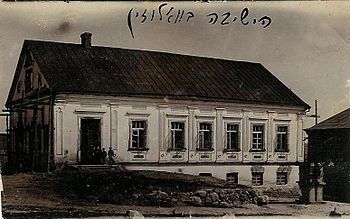Nati Helfgot
In the decades before World War I, and more prominently in the interwar decades of the 1920s and 1930s, Rabbi Hayyim Soloveitchik’s analytical method of Talmud study captured the imagination of students throughout the over thirty Lithuanian yeshivot. Rav Hayyim was one of the longtime heads of the Etz Hayyim Yeshiva in Volozhin. Marked by its emphasis on Rambam’s codes, Rav Hayyim’s revolutionary method of Talmud study came to be known as the “Brisker method,” owing to Rav Hayyim’s tenure in Brisk (today Brest in Belarus) during the last 25 years of his life.
All of this is well-known to modern day students of Talmud. However, it is somewhat challenging to gauge the enthusiastic reception of Rav Hayyim’s intellectual Talmud revolution. Rav Hayyim did not publish anything in his lifetime. The impact of his teaching was due to the spread of his Torah and methodology by key students who later emerged as roshei yeshiva in various institutions during this period. Many of his insights were transmitted orally from one generation of students to the next and spread throughout the yeshiva world, creating a living tradition that extended far beyond Rav Hayyim’s demise.
In addition, in the interwar years, groups of advanced students from leading yeshivot such as Slabodka near Kovno, Mir, Kletsk, and Kaminetz began attending a special learning circle in Brisk led by Rav Hayyim’s son, Rabbi Yitzhak Zev Soloveitchik. The so-called Brisker Rav assumed the mantle of his father’s rabbinate. These prominent students would spend a few months studying with the Brisker Rav, imbibing the methodology and many Torah expositions of his distinguished father. Then they would return to their home institutions to share and disseminate the Torah of Brisk.
It was in the aftermath of those experiences that various yeshiva students began transcribing short Torah essays in Rav Hayyim’s name. These were eventually replicated by mimeographed stencils and spread throughout the yeshiva world. These short bits of Torah were recorded from memory, unauthorized by the Soloveitchik family at the time, and, though they gained wide dissemination in yeshiva circles, may have contained errors of transmission. (In the Brisker yeshivot of Jerusalem, the practice is not to use these writings.)
In the years after Rav Hayyim’s death, his family and prominent students such as Rabbi Boruch Ber Leibowitz, the Rosh Yeshiva in Kaminetz, began the process of publishing an authorized edition of Rav Hayyim’s novellae on the Talmud and Rambam. On April 7, 1927, Rabbi Leibowitz sent a letter in elegant rabbinic Hebrew to Rabbi Aharon Teitelbaum, secretary of the Central Relief Committee (an Orthodox organization founded during WWI to provide aid to individuals and yeshivot). In the letter, Rabbi Leibowitz requested that the committee allocate $600 to enable the Brisker Rav and his brother, Rabbi Moshe Soloveitchik, to publish their father’s novellae which were by then ready for publication.
Towards the end of the letter, Rabbi Leibowitz departed from his prose, waxing poetic—suffused with biblical and rabbinic allusions—over his excitement over the possibility that his master’s teachings will see the light of day. Below are Rabbi Leibowitz’s words and my translation of the short poem:
כי אז תהיה אורה ושמחה ליהודים
כל השערים המצוינים בהלכה יאירו ויפתחו לרווחה
וכל סתום וחתום וכל קשר תעודה יותרו
כאיל תערוג על אפיקי מים כן תערוג נפש תלמיד על רב. ישיש עם צורב
ששה יתכסו בטלית אחד לשמוע דברי תורת רבינו זיע”א
לדור דורים בנים אשר יולדו ממקור ישראל כולם
גם עוברים במעי אמן יפתחו פיהם כבשירה על הים
כדבש מסלע ישבעו מתורת רבינו דים
For then there will be light and joy to the Jewish people
All the illustrious gates of Halakha will shine and open wide
All that is hidden and secret and every bound source will be unlocked
As a deer longs for running streams, so does the soul of the student long for the master. The nation seared with pain shall rejoice
Six people will come under a single cloak to hear the words of our master, may his merit protect us, amen
For eternity, all Jewish children
Including even fetuses in the wombs of their mothers, will open their mouths as if to sing the song at the sea
As honey from the rock they will satiate themselves fully from the teachings of our master.
In 1936, Rav Hayyim’s sons published the volume known to the Torah world as Hiddushei Rabbeinu Chaim ha-Levi al ha-Rambam. At the dedication of the new building for Rabbi Leibowitz’s yeshiva in Kaminetz that took place a short while later in 1936, he reportedly led the parade in dancing while grasping his freshly minted copy of his beloved teacher’s work in his bosom.










 Site Operations and Technology by The Berman Consulting Group.
Site Operations and Technology by The Berman Consulting Group.